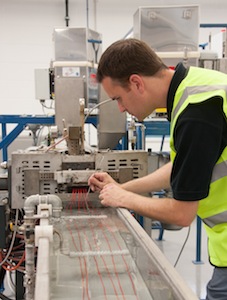 Grimsby. It’s not normally thought of as a hotbed of technological, indeed any, innovation. Luckily, I was merely passing through on my way to Louth, where something more interesting was happening. At an industrial estate on the edge of town, an independent technical compounder and recycler is developing a new range of lightweight polypropylene (PP) products which contain up to 60% recycled content, intended for the interior trim market. The company has just received £600,000 ($907,000) of funding from the EU to commercialise the range and has also persuaded JLR to come on board for end-user trials.
Grimsby. It’s not normally thought of as a hotbed of technological, indeed any, innovation. Luckily, I was merely passing through on my way to Louth, where something more interesting was happening. At an industrial estate on the edge of town, an independent technical compounder and recycler is developing a new range of lightweight polypropylene (PP) products which contain up to 60% recycled content, intended for the interior trim market. The company has just received £600,000 ($907,000) of funding from the EU to commercialise the range and has also persuaded JLR to come on board for end-user trials.
Established in 1965, the somewhat ironically named Luxus (Latin for ‘luxury’) has a long history of plastics recycling, and since the 1980s has invested in its technical capabilities with laboratory-based polymer development work. Its 50th birthday present from the EU has enabled the purchase of a new twin-screw, co-rotating extruder from Coperion which is intended both to optimise material properties and to increase output by 12,000 tonnes per year, boosting overall capacity by 45%.
Since I have toured vehicle plants almost as often as I have taken out my recycling, I was intrigued to visit a facility that was sure to be a little different. I was not disappointed. Catching sight of a crate of human feet in the delivery yard, I initially felt it might have been a mistake to come alone; fortunately, technical manager Terry Burton was on hand (excuse the pun) to put my mind at rest. The feet were shoemaker’s mannequins and here to be recycled, alongside KitKat wrappers, supermarket pallets, diesel tanks, bottle banks and product from other recycling companies. But few of these items will end up as interior trim; the requirements of the automotive industry for high tensile strength and surface quality mean that only the pallet-type material is suitable.
The feedstock is progressively reduced in size by a series of machines inside Luxus’ recycling facility. The raw materials are melted and mixed by extruders, which also filter out scraps of cardboard and paper; lying on the floor are large green blobs of waste which look a lot like Slimer from Ghostbusters.
An interesting point about the operation here is the fact that, unlike in a press shop, the feedstock varies to the extent that a new ‘recipe’ is created on each occasion. Quality control, and persuading customers of its veracity, is Luxus’ top priority. Thus, the compounding facility a short walk from the recycling centre not only contains the main production area (including the Coperion machine), where the final pellets are made and bagged up, but a laboratory full of testing equipment.
The focus of Luxus’ new Hycolene range is on removing the heavier minerals from the compounds, reducing weight by 12% while maintaining the properties which enable the production of strong and scratch-resistant interior products. Besides the high proportion of recycled content, the weight saving will help to reduce vehicle emissions. With plans to license the IP within Europe, Luxus aims to gain a 2% share of the EU interior trim market by 2016.
Given the EU’s fondness for edicts on vehicle emissions and recycled content, its funding for Luxus was effectively a birthday present to itself, but supporting sustainability in the automotive industry is certainly a vast improvement on numerous other schemes which have involved the wrong kind of waste (cf Donkeypedia). Having visited Luxus, I feel reassured that on this occasion the EU has put my money where its mouth is.























